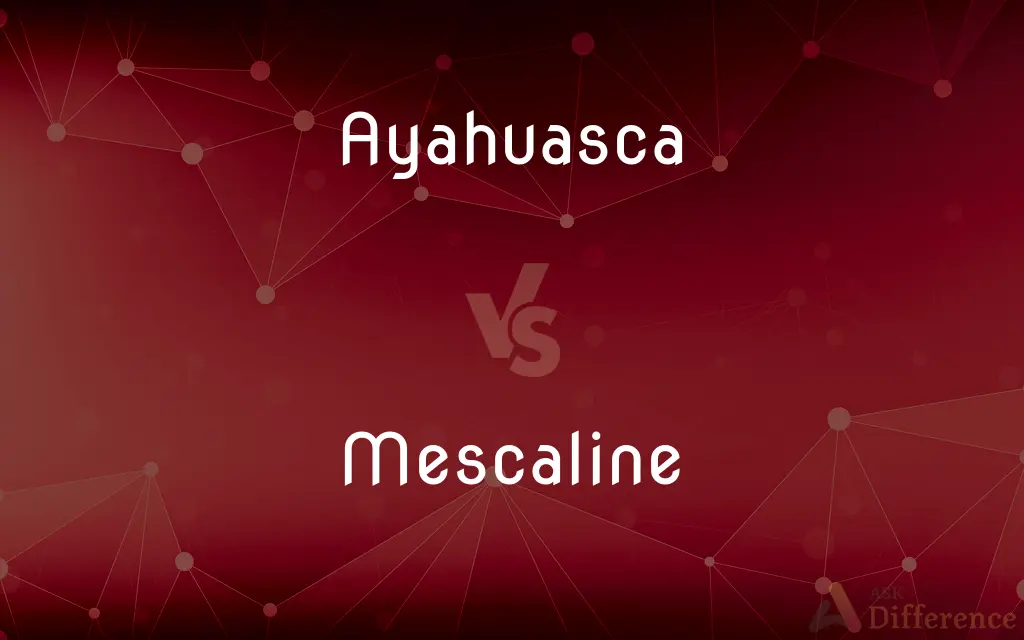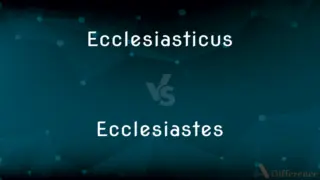Ayahuasca vs. Mescaline — What's the Difference?
Edited by Tayyaba Rehman — By Maham Liaqat — Updated on April 27, 2024
Ayahuasca is a brewed concoction containing DMT, known for deep spiritual experiences, often in a ceremonial context, whereas mescaline is a psychoactive alkaloid found in cacti, famous for vivid visual hallucinations and introspection.

Difference Between Ayahuasca and Mescaline
Table of Contents
ADVERTISEMENT
Key Differences
Ayahuasca, traditionally used in South American shamanic rituals, contains DMT and MAOIs, creating long-lasting psychoactive effects. In contrast, mescaline is primarily derived from the peyote and San Pedro cacti and is known for inducing prolonged states of psychedelic experience.
The ayahuasca experience is often described as a journey or voyage, frequently accompanied by intense emotional and psychological revelations. On the other hand, mescaline is typically associated with enhanced visual hallucinations and a profound sense of connectivity to the natural world.
Ayahuasca is usually consumed in a controlled, ceremonial setting under the guidance of an experienced shaman, emphasizing spiritual healing and exploration. Whereas mescaline can be used in similar ritualistic settings but is also popular recreationally and in personal spiritual quests outside of traditional contexts.
Preparation of ayahuasca involves boiling its components, like Banisteriopsis caapi and Psychotria viridis, for several hours to extract the active compounds. Conversely, mescaline is extracted from cactus buttons by drying and chewing them or brewing them into a tea.
The legal status of ayahuasca varies by country, often reflecting its cultural and spiritual significance. However, mescaline, especially from peyote, is regulated in many countries, with exceptions typically for religious use by indigenous groups like the Native American Church.
ADVERTISEMENT
Comparison Chart
Primary Component
DMT and MAOIs
Mescaline alkaloid
Origin
Amazon basin, South America
Peyote and San Pedro cacti, Americas
Typical Use
Shamanic ceremonies, spiritual healing
Spiritual, ceremonial, recreational use
Effects
Deep psychological exploration, emotional healing
Vivid visuals, heightened sense of connection
Legal Status
Varied, often restricted to ceremonial use
Generally controlled, some religious exemptions
Compare with Definitions
Ayahuasca
Contains naturally occurring DMT, a powerful hallucinogen.
Ayahuasca’s active ingredient, DMT, is responsible for its profound psychological effects.
Mescaline
A hallucinogenic compound found in certain cacti.
He extracted mescaline from peyote cacti for his personal spiritual journey.
Ayahuasca
A psychoactive brew used primarily for spiritual and therapeutic purposes.
The group participated in an ayahuasca ceremony to seek deeper self-understanding.
Mescaline
Generally ingested in the form of dried cactus buttons.
He chewed the dried peyote buttons, slowly experiencing the onset of mescaline’s effects.
Ayahuasca
Traditionally used by indigenous tribes in the Amazon.
Indigenous tribes have used ayahuasca for centuries as a tool for spiritual guidance.
Mescaline
Used both recreationally and as part of traditional spiritual practices.
Some use mescaline in a ritual context, while others explore its effects recreationally.
Ayahuasca
Involves a brew made from specific vines and leaves.
The shaman prepared the ayahuasca by brewing Banisteriopsis caapi with Psychotria viridis leaves.
Mescaline
Has a long history of use among Native American peoples.
Native American tribes have used peyote, a source of mescaline, in their religious ceremonies for millennia.
Ayahuasca
Effects can include intense visions, insights, and emotional upheaval.
During the ayahuasca experience, many report encountering vivid, symbolic visions.
Mescaline
Known for causing colorful visual hallucinations and altered states.
Mescaline led to a series of intense, colorful visual episodes that lasted several hours.
Ayahuasca
Ayahuasca is a South American (pan-Amazonian) psychoactive brew used both socially and as ceremonial spiritual medicine among the indigenous peoples of the Amazon basin. It is a psychedelic and entheogenic brew commonly made out of the Banisteriopsis caapi vine, the Psychotria viridis shrub or a substitute, and possibly other ingredients.
Mescaline
Mescaline (3,4,5-trimethoxyphenethylamine) is a naturally occurring psychedelic protoalkaloid of the substituted phenethylamine class, known for its hallucinogenic effects comparable to those of LSD and psilocybin. It occurs naturally in the San Pedro cactus (Trichocereus (Echinopsis) pachanoi), the Peruvian torch (Trichocereus peruvianus (Echinopsis peruviana)), the Bolivian torch cactus (Echinopsis lageniformis), the peyote cactus (Lophophora williamsii), and other species of cacti.
Ayahuasca
A hallucinogenic brew made from the bark and stems of a tropical South American vine of the genus Banisteriopsis, especially B. caapi, mixed with other psychotropic plants, used especially in shamanistic rituals by certain Amazonian Indian peoples.
Mescaline
A hallucinogenic alkaloid, C11H17NO3, obtained from peyote buttons and used by certain Native American tribes in religious rituals and illicitly as a recreational drug.
Ayahuasca
A giant vine native to South America (especially Banisteriopsis caapi), noted for its psychotropic properties.
Mescaline
(biochemistry) A hallucinogenic and intoxicating compound present in the peyote cactus (Lophophora williamsii), the San Pedro cactus (Echinopsis pachanoi), and the Peruvian torch (Echinopsis peruviana).
Ayahuasca
Any of various psychoactive infusions or decoctions prepared from this vine.
Mescaline
The hallucinatory alkaloid that is the active agent in mescal buttons
Common Curiosities
What are the primary differences between ayahuasca and mescaline?
Ayahuasca involves a combination of DMT and MAOIs, often used in ceremonial settings, while mescaline is a single compound used in both sacred and secular contexts.
Can ayahuasca and mescaline lead to similar experiences?
Both can lead to profound psychological and visual experiences, but ayahuasca is often more introspective and mescaline more visual.
Is it legal to use ayahuasca or mescaline?
Legal status varies by country and context; ayahuasca is sometimes allowed for religious or spiritual ceremonies, while mescaline is often regulated but can be used legally by specific indigenous groups.
Are there any risks associated with using ayahuasca or mescaline?
Both substances can cause significant psychological distress if not used carefully, with risks heightened by pre-existing mental health conditions.
How long do the effects of ayahuasca and mescaline last?
Effects of ayahuasca can last 4 to 8 hours, while mescaline can last up to 12 hours depending on the dose.
Can ayahuasca and mescaline be used for therapy?
Ayahuasca is increasingly used in therapeutic settings for mental health issues like depression and PTSD; mescaline has been explored less extensively.
How do users prepare for a session with ayahuasca or mescaline?
Preparation typically involves dietary and mental preparation, especially for ayahuasca, which may also require guidance from a shaman or experienced facilitator.
What are the physical effects of taking ayahuasca or mescaline?
Both can cause nausea and vomiting; ayahuasca often more so, and both alter perception and can cause changes in heart rate and blood pressure.
How do individuals typically source ayahuasca or mescaline?
Ayahuasca is usually brewed by knowledgeable practitioners, while mescaline is extracted from cactus that is either grown or wild-harvested.
What role do set and setting play in experiences with ayahuasca and mescaline?
Both substances require careful consideration of set (mindset) and setting (environment) to ensure safe and positive experiences.
What should first-time users know before trying ayahuasca or mescaline?
First-time users should be aware of the psychological intensity and potential for challenging experiences, and ideally be guided by experienced users or facilitators.
How do the visual experiences differ between ayahuasca and mescaline?
Ayahuasca visuals are often described as more narrative or journey-like, while mescaline produces more geometric and intensely colorful visuals.
How do ayahuasca and mescaline affect one's sense of time?
Both can profoundly alter the perception of time, often making the experience feel much longer than it actually is.
Can ayahuasca or mescaline lead to addiction?
Neither substance is generally considered addictive, but psychological dependency can develop, especially without proper guidance and support.
What cultural significance do ayahuasca and mescaline hold?
Ayahuasca is central to some South American indigenous cultures for spiritual healing; mescaline has similar significance in Native American spiritual practices.
Share Your Discovery

Previous Comparison
Castor vs. Caster
Next Comparison
Ecclesiasticus vs. EcclesiastesAuthor Spotlight
Written by
Maham LiaqatEdited by
Tayyaba RehmanTayyaba Rehman is a distinguished writer, currently serving as a primary contributor to askdifference.com. As a researcher in semantics and etymology, Tayyaba's passion for the complexity of languages and their distinctions has found a perfect home on the platform. Tayyaba delves into the intricacies of language, distinguishing between commonly confused words and phrases, thereby providing clarity for readers worldwide.














































